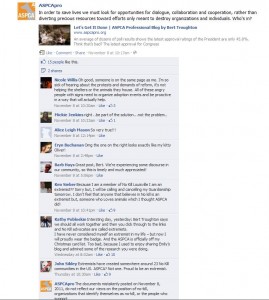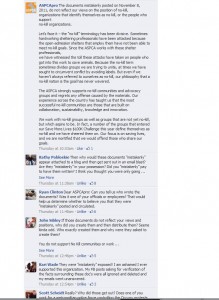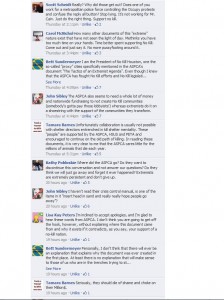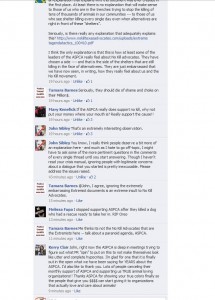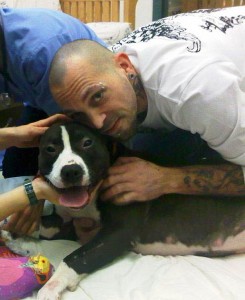
The ASPCAPro webpage as it appeared before certain extremely embarrassing documents were made to disappear. Click to enlarge.
Until Tompkins County became the first No Kill community in U.S. history, No Kill was said to be impossible. When other communities followed suit, it became probable. When we cross the tipping point, it will become inevitable.
~Nathan Winograd, from “On Leadership”
Yesterday morning, a friend emailed me a couple of links that she’d seen the ASPCA was promoting on Facebook and in email blasts. Of particular note was a document entitled “The Tactics of the Extremist Agenda.” I am so taken with it that I will quote it in its entirety, in addition to linking to a pdf.
Here it is:
The Tactics of the Extremist Agenda
Step 1: Establishing a Proxy
A member of a community will begin to adopt the talking points of the Extremist Agenda, using aggressive and divisive language to describe the state of that community’s animal welfare organizations.
Step 2: Creating a Local Organization
The proxy forms an organization (i.e. “No Kill Austin/Louisville/Houston/Philly) that will act as the local brand for the Extremist Agenda and begin to use social networking to expand.
Step 3: Engaging in Local Politics
The no-kill organization lobbies local public officials and candidates regarding the existing euthanasia rates at the municipal shelter. In most cases, there does exist public attention to the need to reform the sheltering system to increase lifesaving.
• The proxy organization will get involved in local elections, providing questionnaires and financial support to candidates perceived as sympathetic to the Extremist Agenda.
Step 4: Slandering Existing Animal Welfare
The Extremist Agenda slanders the existing shelter director and any local humane organization that is deemed to be sympathetic to the status quo. The aim of the slander is to put enough pressure on the director to step down (which is often achieved).
Step 5: Installing a Puppet Regime
A new “compassionate” director sympathetic to the Extremist Agenda is put in place through effective lobbying. The Extremist Agenda organization will often advocate a candidate with little or no experience who will essentially do as they are told.
Step 6: Saving Face when the Agenda Fails
The Extremist Agenda displaces blame when the program becomes unsustainable by blaming either their own director or local public officials for not backing them sufficiently.
Step 7: Slandering Media
Attacking unfavorable media is commonplace for the Extremist Agenda when a story runs that questions any component of implementing overnight solutions while demonizing hardworking animal welfare organizations.
I am nonplussed once again. I didn’t think I could be, but I am. I love the First Amendment. It’s my favorite. Why are they trying to make it seem so–dirty? And, holy crap! Somebody figured out how to channel Senator Joe McCarthy!
Are you a citizen concerned about abuse and killing at your local animal shelter (paid for with your tax dollars and/or donations)? The ASPCA calls you a ‘proxy’. Do you believe that shelters should implement the No Kill Equation, saving 90+% of all homeless pets in the community? According to the ASPCA, you are a proponent of the dreaded “Extremist Agenda.” Do you speak the truth about the abuse and killing at your local “shelter”? Do you call out killing apologists? According to the ASPCA, you are committing slander, being divisive, and demonizing. According to the ASPCA, a compassionate shelter director committed to the No Kill Equation is a puppet and needs to be corralled within scare quotes.
According to the ASPCA, “In most cases, there does exist public attention to the need to reform the sheltering system to increase lifesaving.” So, what’s the bigger problem to them—the fact that so-called shelters kill needlessly and spitefully (as when rescue is en route) and abuse animals in the process, or the fact that this reckless irresponsibility and malice is making its way into the public eye?
Plus, all of their name-calling combined with their admonitions against slander and divisiveness would be comical if they didn’t perpetuate tragedy after tragedy.
I noticed that the ASPCA name and logo were conspicuously absent from these documents. Why would they leave that stuff off? Deniability? The document properties for “The Tactics of the Extremist Agenda” indicate that it was created on October 4, 2010, so apparently, it has been making the rounds behind the scenes for over a year prior to yesterday’s little indiscretion. Another disappearing document, “Engaging Public Officials” was created on October 5, 2010.
Before the day was out, the ASPCA realized that it had done something extremely stupid and pulled two of the more incriminating documents from its website. The link that led to “The Tactics of the Extremist Agenda,” now yields only an error message.

All that is left of the Extremist Agenda" and "Engaging Public Officials" on the ASPCAPro website.
But the internet being what it is, once the proverbial lolcat is out of the bag, it’s on more hard drives than you can count and it ain’t going back in.

Mission Orange kitteh wants you to STFU
When I first saw these webpages, I had a feeling that they might not be long for this world, so I took the screenshot at the top of this post for posterity and downloaded “The Tactics of the Extremist Agenda” and “The Psychology of Attacks and Attackers” (I got a particular charge out of their effort to create a perception of a ‘slippery slope’ whereby the presentation of legitimate concerns becomes a verbal ‘attack’ and segues into ‘violence’. Smarmy, smarmy, smarmy. Never mind that these people commit actual violence every time they kill an animal.) I also downloaded “Engaging Public Officials.” I wasn’t the only Extremist No Kill advocate who did. John Sibley also preserved “The Tactics of the Extremist Agenda” and “Engaging Public Officials” for your entertainment. He’s an extremely civic-minded dude.
It’s worth having a look at the remaining links on the “Tools for Humane Discourse” page while they last. Try not to get whiplash from all the irony.
“Let’s Get It Done” contains the telling statement, “We stand to lose something even more valuable than votes – the public’s money and time.” I thought I’d highlight that statement because it is one of the only ones in the whole lot that is both honest and truthful. I’m extremely helpful that way.
If your sense of humor is sufficiently warped, you might enjoy the “Pledge for Humane Discourse” almost as much as I did. Upon scanning the list of signatories who pledged:
We the undersigned individuals and organizations, in conjunction with the Humane Society of the United States (HSUS), reject and condemn verbal abuse, threats, and acts of violence directed against animal welfare personnel. There is no place in the humane movement for physical or verbal intimidation, violence, or acts of terrorism.
Such behavior is wholly inconsistent with a core ethic of promoting compassion and respect, and undermines the credibility of the entire animal welfare movement. Our goal must be to affirm the value and integrity of all life, whether animal or human, and to encourage others to do likewise. Verbal attacks, threats, harassment, defamation, and acts of violence, moreover, do not ultimately help animals. Instead, they eliminate opportunities for dialogue, collaboration and cooperation, making our shared goals, including that of ending the euthanasia of healthy, adoptable animals, harder to achieve. A free and respectful exchange of views in the ongoing national conversation about animal welfare practices, including animal sheltering practices, is the standard to which humane organizations and communities should aspire and adhere.
We call on every animal welfare group and advocate to join us in actively promoting compassion and respect not just for animals but for those people who work tirelessly on their behalf. Please pledge your commitment by adding your name below.
A few names jumped out at me—
- The Humane Society of Berks County, Reading, PA, whose director, recently told an anti-gassing advocate to “go f*** yourself” in an email.
- Charlotte-Mecklenburg Animal Care & Control, Charlotte, NC , with a long list of documented abuse of animals and intimidation of advocates.
- Miami-Dade Animal Services Department, Miami, FL, which was recently exposed for extreme cat abuse and killing caught on camera. No Kill advocatesExtremists spoke out, endured attacks, and now there’s hope.
- Gaston County Animal Control, Dallas, NC. Apparently it is so named because, at least until recently, it gassed tons of animals.
- Houston SPCA, Houston, TX, which has a very high kill rate and tries to take in still more animals, even from places where they are safe.
Killing apologists find plenty of room “in the humane movement for physical or verbal intimidation, violence, or acts of terrorism” when they are the ones doing the intimidating, which is one reason why we have National Animal Shelter Reform Week. I’d like to thank the ASPCA for inadvertently adding to this week’s revelry.
Proponents of the Extremist Agenda Animal-lovers and No Kill advocates should, most of all, view this episode as a sign that we have gained enough ground that killing apologists (even those with literally over $100 million at their disposal) regard the current situation as a crisis and are starting to (pardon the non-vegan metaphor) run around like a bunch of chickens with their heads chopped off. A crisis is, by definition, a dynamic situation—danger mixed with opportunity. (They’re in danger of being exposed for what they are—people and organizations who value money and power over the lives of animals; and we have the opportunity to make “shelters” into real shelters. They have the opportunity to change and get on board with the Extremist Agenda lifesaving; and we are in danger of being labeled “extremists” and subjected to various and sundry other nastiness.) It is heady, exciting, exhausting and the time when real leaders emerge. It means we are at, or very near, the tipping point.
The old ‘catch and kill’ monolith is showing its cracks. It’s up to us to replace it with a new, extremely life-affirming paradigm.
“I don’t think these documents make our job harder; I think they make our job easier,” said Ryan Clinton of Fix Austin, one of the groups the disappearing ASPCA documents referred to specifically as ‘extremist’. “Any time you get a hold of the other side’s ‘talking points,’ it destroys their credibility with public officials and media. I particularly love the line that says “Public officials who are leaning in the Extremist direction need to be handled cautiously.””
I am extremely grateful for that.

